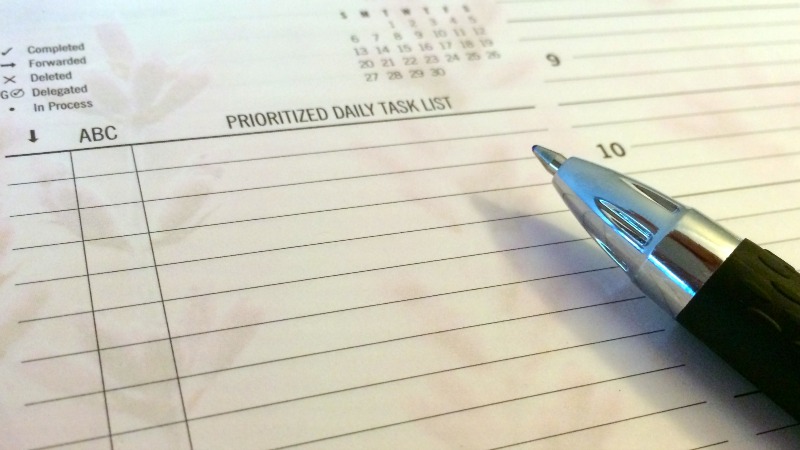One of the rites of passage when my sisters and I started seventh grade was getting our own planner. Our parents would take us down to the Franklin Quest store and let us pick out our own binder and pages. In addition to the standard kit, we would also get the student pack, which had special forms for tracking homework assignments and class schedules.
We would sit down and plan the week as a family each Sunday night. I learned the importance of daily planning by watching my parents set aside a few minutes early in the morning to review the day. They showed us how to see the day in the context of the week (and the week in context of the month, etc) and prepare not just for today but for the coming days, as well.
I don’t know how my sisters felt about it, but I absolutely loved it. Don’t get me wrong—I was still a teenager, and I would still procrastinate on homework, but the foundation they had laid allowed them to have different conversations than most parents probably do. “Can I go to the movies?” “Have you finished your A tasks for the day?” …and I knew they had me. And they knew it.
I used a Franklin planner from junior high until 2010, when the iPad was released. Now, my tools are (mostly) digital. Yours probably are, too. But a prioritized daily task list is still one of the most powerful tools you have to get things done.
First, select your tasks for the day. Management consultant Ivy Lee recommended selecting tomorrow’s tasks at the end of the day, but you can also do it first thing in the morning.
The Ivy Lee Method leaves you with an ordered list of tasks. Just work your way down the list. If this is enough for you to be productive, then just do that. Do the simplest thing that will get you the results you want.
If you’re still getting swamped, especially as you get interrupted and new tasks come in, assign ABC priorities to your tasks. First, go through each task on your list and assign it one of the following letters:
- A — Critical. There are two types of A tasks. Quadrant 1 tasks are Urgent and Important—there will be serious consequences if this doesn’t get done today. Then there are the Quadrant 2 tasks (Important, but not Urgent), which set you up for bigger and bigger wins tomorrow.
- B — Expected. These aren’t as important as A tasks, but it would still be good to get to them sooner rather than later. There may be consequences if they don’t get done today, but it won’t be the end of the world.
- C — Maybe. If you get to these tasks, great. You’ll get a head start on tomorrow or tidy up a bit, but it’s possible that no one would notice if you didn’t do this (or notice if you did).
Recently, I’ve seen two more letters get added in. They’re a little tongue-in-cheeks, but they’re good to keep in mind as you’re doing this.
- D — Delegate it. If you aren’t the right person to do this, hand it off.
- E — Eliminate it. This is no longer relevant or important. The time has come to say goodbye.
Now go back and look at your A tasks. Out of those tasks, which one is most important to get done? Put a 1 next to it. This is your A1 task. Which task is the next most important? Put a 2 next to it, and so on. Do the same for the B and C tasks.
Why spend the extra time to number your list like this? It comes down to two benefits:
- Know when you can call it a day. When it’s time to call it a day, your A tasks need to be complete. You need to stay late at the office or miss The Tonight Show because you still have work to do. If your top remaining task is B3, it will wait until tomorrow.
- Prioritize incoming tasks more easily. Some new tasks that come in during the day need to be done today, and some just need to be done “today”. If the new task is so urgent that it needs to be done today, slot it in with the other A tasks. It’s one more thing to do before five o’clock. If the task just needs to be done sometime soon, slot it in with your B/C tasks or drop it in your inbox for later processing.
Most of the work in creating your prioritized daily task list will be in coming up with the list of tasks itself. Prioritizing them shouldn’t take very long, and it can pay huge dividends in your productivity. Not only do you know what you need to be working on now and next, but it forces you to decide whether some tasks even need to be done or can be eliminated altogether.
Remember: a plan is nothing, but planning is everything (—Eisenhower). By taking a few minutes to plan your day before starting to work, you will be much better prepared for whatever comes.
Question: How has planning your day helped you to be more productive? Share your thoughts in the comments, on Twitter, LinkedIn, or Facebook.
Never Miss a Post
When you sign up to receive my blog posts by email, you’ll get a FREE copy of The Digital Goal Domination Guide, my new ebook that will show you how to reach your goals using OmniFocus and Evernote. Get more done this year than you ever thought possible!
PLUS, you’ll receive occasional bonus content and special offers, some of it not available on the blog.
